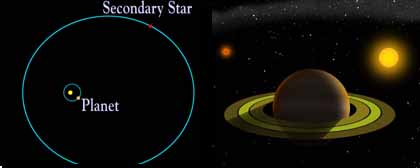The planet is larger than Jupiter and orbits the main star in the system at a distance similar to that of Mars from the Sun. The orbit of Uranus already has a sun, the secondary planet in the system
Direct link to this page: https://www.hayadan.org.il/extrabinary.html
Avi Blizovsky

An artist's illustration of the Gamma Cephei system and the orbital configuration
The first planet orbiting a star in a binary star system leads to the conclusion that the galaxy contains many more planets than previously estimated.
Unlike our Sun, which is a rare example of a lone star in the battle, most stars in the Milky Way have companions. The discovery suggests that binary systems can host planets like single stars. said astronomers on Wednesday (9/10/2002). The planet is larger and more massive than Jupiter and it orbits the larger star of the two, slightly more than the average distance between the Sun and Mars and therefore it orbits its Sun once every two and a half years.
The big star is 1.6 times more massive than the Sun. Like the discovered planet, the companion star orbits the larger star at about the same distance as the Sun and Uranus.
This is the first time we have found a planet in a relatively close binary star system, says Michael Endel of the University of Texas at Austin, a member of the team studying the star system.
"Since most of the stars in our galaxy share a double or even multi-star system, the discovery has implications for the question of how many solar systems are in our galaxy" says Endel.
A number of extrasolar planets have already been discovered around other binary systems, but in those cases, the companion star was hundreds of meters away from the central star, compared to the second star in the Gamma Cephei system. The stars in other systems were so far away that they behaved independently, says Bill Cochran, also on the team and at the University of Austin.
"In such systems, each star can be considered isolated because they have little mutual gravitational influence, so finding planets would be a relatively small surprise," says Endel.
However, planets can only be observed rarely in a system like Gamma Cephei where there is a great proximity between the stars. When the stars are so close together they can interfere with the orbits of nearby planets, astronomers say.
Cochran and a group that also includes astronomers from Canada and Germany have been studying the Gamma Cephei double system for several decades using a variety of telescopes. A two-and-a-half-year periodic change in the brightness of the light convinced the researchers that the main star had planets.
The star itself is not a variable star, so the conclusion after twenty years of testing, which includes eight complete cycles, is that a planet hides the star's light. Gamma Cephei is 45 light-years away from us and appears as a single point of light in the direction of the North Pole. It marks the tip of the cap of the Kephaus or "King" star system.
Know planets outside the solar system
https://www.hayadan.org.il/BuildaGate4/general2/data_card.php?Cat=~~~343653380~~~54&SiteName=hayadan
